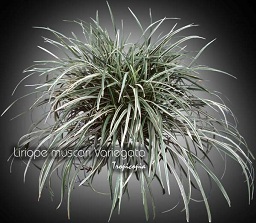Table of contents
Variegated lily-turf

Latin Name: Liriope muscari ‘ Variegata’
Category: Foliage plant
Family: Liliaceae
Origin: Japan
Climate: Subtropical
Growing Zones: 11, 8
Care Instructions
The Variegated lily-turf (Liriope muscari ‘ Variegata’) is a subtropical plant that originates from Japan. This foliage plant plant belongs to the Liliaceae family and is well-suited for growing in USDA zones 11, 8.
Complete Care Guide for Variegated Lily-Turf (Liriope muscari ‘Variegata’)
Watering Requirements
The Variegated Lily-Turf, or Liriope muscari ‘Variegata’, is a resilient plant that thrives with moderate watering. It is essential to keep the soil consistently moist, especially during the growing season in spring and summer. However, be cautious not to overwater, as this can lead to root rot. A good rule of thumb is to water the plant deeply once a week, allowing the top inch of soil to dry out between waterings. In particularly hot or dry conditions, you may need to increase the frequency of watering. During the fall and winter months, reduce watering as the plant enters dormancy, ensuring the soil remains slightly moist but not soggy.
Light Conditions
Variegated Lily-Turf prefers partial to full shade, making it an excellent choice for shaded garden areas or under trees. While it can tolerate some direct sunlight, especially in the morning, too much harsh afternoon sun can scorch the leaves and diminish the vibrancy of its variegated foliage. Ideally, aim for a location that receives dappled sunlight or filtered light throughout the day. If planted in full sun, ensure that the soil retains moisture to prevent stress on the plant.
Soil Preferences
The ideal soil for Variegated Lily-Turf is well-draining, rich in organic matter. A loamy or sandy soil mix is preferred, as it allows for adequate drainage while retaining some moisture. The pH level should be slightly acidic to neutral, ranging from 6.0 to 7.0. To enhance soil fertility, consider incorporating compost or well-rotted manure into the planting area before planting. Fertilization is generally not necessary, but a balanced, slow-release fertilizer can be applied in early spring to promote healthy growth. Avoid over-fertilizing, as this can lead to excessive leaf growth at the expense of flowering.
Pests and Diseases
While Variegated Lily-Turf is relatively pest-resistant, it can occasionally be affected by common garden pests such as aphids, spider mites, and slugs. Regularly inspect the foliage for signs of infestation, such as discolored leaves or webbing. If pests are detected, treat them promptly with insecticidal soap or neem oil, ensuring to follow the manufacturer’s instructions. Additionally, the plant can be susceptible to fungal diseases like leaf spot and root rot, particularly in overly wet conditions. To prevent these issues, ensure proper spacing between plants for air circulation and avoid overhead watering. If leaf spots appear, remove affected leaves and apply a fungicide if necessary.
Special Care Tips
To maintain the health and beauty of your Variegated Lily-Turf, consider the following special care tips: First, regular pruning is beneficial; trim back any dead or damaged leaves in early spring to encourage new growth. Additionally, mulching around the base of the plant can help retain soil moisture and suppress weeds. If you live in a colder climate, consider applying a layer of mulch in the fall to protect the roots during winter. This plant is also excellent for erosion control on slopes due to its dense root system. Lastly, if you wish to propagate your Variegated Lily-Turf, division is the most effective method. This can be done every few years in early spring or fall, ensuring that each division has a healthy root system.








